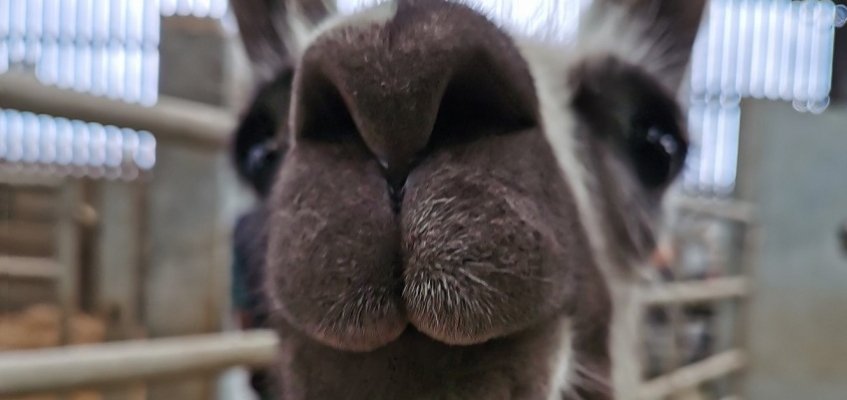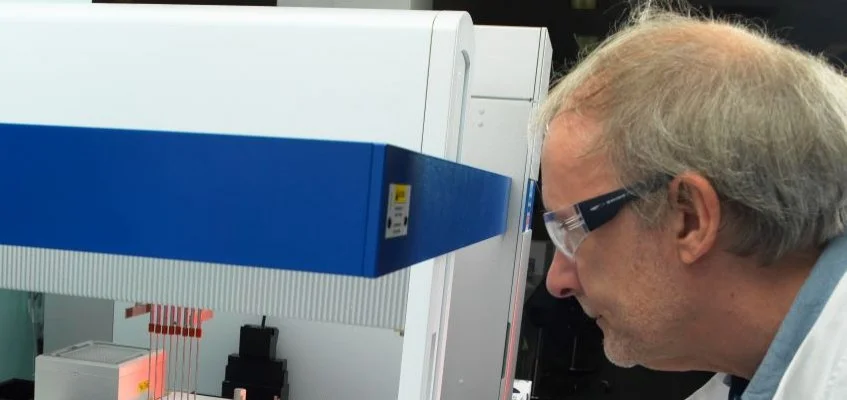Covid-fighting llamas at the Royal Society Summer Science Exhibition
The Rosalind Franklin Institute and University of Reading have worked together to create an interactive exhibition about their research on Covid-19 treatments for the Royal Society Summer Science Exhibition in London.
Bringing together expertise and technical support from the Universities of Oxford and Reading, the Franklin’s Protein Production UK programme uses new technologies – with the help of llamas – to create nanobodies that could one day be used as drugs to treat Covid-19.
Nanobodies with special binding abilities
Nanobodies are tiny antibodies that bind with proteins on the outside of a virus, blocking normal virus processes and helping the body to fight disease. They can only be created using antibodies found in the blood of llamas and other camelids. This is because llamas produce unique, heavy-chain only antibodies not found in other mammals.
Research into nanobodies could lead to an exciting new range of highly effective drugs against rare or difficult-to-treat diseases like Covid-19. Their small size means they can squeeze into parts of the SARS-CoV-2 coronavirus that other antibodies cannot reach.
Professor Ray Owens, who leads the Nanobody Discovery programme at the Franklin, said: “The spike protein found on the outside of coronavirus is one of the best targets for Covid-19 drug treatments. If we can create a drug that recognises the spike protein and then binds to it, it will prevent the virus from getting inside cells and reproducing. Nanobodies are unique because of the way they bind to the spike protein with such a high affinity. Our research looks to develop nanobodies as potential drugs.”
Working with the University of Reading’s Centre for Dairy Research (CEDAR), Professor Owens’ team vaccinate CEDAR’s llamas with the SARS-CoV-2 spike protein. The llama’s unique antibodies are then collected through a small blood sample and taken back to the Franklin. Here, the genetic code of the nanobodies is isolated and amplified.
The researchers then produce nanobodies in the laboratory, which are trialled in an animal model as possible drugs against Covid-19. Since nanobodies show promise against other diseases, it is hoped that the Franklin’s Covid-19 nanobodies could eventually be used in human clinical trials.
Explaining how Fifi the llama fights viruses
In Summer 2022, Professor Owens’ nanobody research was transformed into a series of engaging activities for the Royal Society Summer Science Exhibition. The exhibition is an annual event in Central London with experiences for anyone curious about advances in science and technology.
Once their application was approved, the Franklin’s communications team swung into action with colleagues at the University of Reading to create a series of fun, informative activities for different ages.
The exhibition focused on Fifi, one of Reading’s llamas used in the research. Alongside a life-size cardboard Fifi sporting her pink bandana, the team developed a Velcro model of a cell, which visitors could throw mini viruses at. To illustrate how an antibody can catch a virus to stop it from grabbing onto cells, they attached a piece of felt in front of the target, to prevent it from sticking.
To aid conversations about how molecules bind and interact, the team used a 3D scale model of the spike protein and a nanobody.
“Given the complexity of the research, we wanted to make the story behind our work with llamas really accessible,” said Professor Owens. “We also recruited everyone who has been involved in the project to deliver the different activities. Luckily for us, there is quite a high level of knowledge and acceptance in the public about vaccination, so scientific concepts that would have been challenging for people to understand a few years ago were easier to talk about.”
A valuable experience
For the University of Reading team, talking about their llama research with the public was something they were well prepared for, having recently won two Understanding Animals in Research Openness Awards.
“We were thrilled to contribute our experiences of communicating this research with the public,” said Professor Gary Stephens, Professor of Pharmacology at the University of Reading. “Public engagement is always valuable, and a huge part of our job is to explain research in ways people can understand. It was a great opportunity to work with the Franklin team to deliver a creative project like this, and then to later use these activities as part of our own public engagement activities with Reading residents.”
Overall, 5,700 people visited the Royal Society’s exhibition in Central London, with 33 school groups taking part in the science careers session.
While the researchers had planned for a range of different questions, there was one they did not have an answer for!
“The main question we were asked was ‘why llamas?’” said Professor Owens. “To be honest, nobody understands why llamas and other camelids produce this distinct type of antibody; it’s just very special and unique to llamas, perhaps due to the harsh environments they are native to. Since nanobodies could one day treat a range of different diseases, working with llamas and then talking about that work openly and creatively is a really rewarding experience for me as a researcher.”
Image below: Professor Ray Owens


